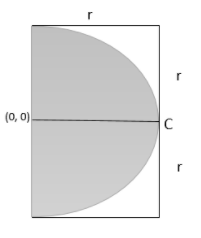
A semicircular disc of radius ‘r’ is removed from a rectangular plate of sides r and 2r. Calculate C.M of remaining portion with respect to origin .


Answer
479.1k+ views
Hint: If we talk about the centre of mass of a body, then this point is dealing with the mass of the whole body. The centre of mass of a body is a point that behaves like the entire mass of the body exists at that point. If we choose a symmetrical body that has a symmetrical mass distribution, then the centre of mass of that body lies exactly at the centre of the body. Like a uniformly shaped pencil of length 10 cm has a centre of mass at 5cm from any end. If a body is heavy at one end, the centre of mass shifts towards the heavy portion. To find the centre of mass in a particular axis we use a formula for two mass systems.
Complete answer:
Position of centre of mass
Here we have
And
Here we can calculate the remaining area by subtracting the area of semicircle from the area of rectangular plates.
Remaining areas = Area of rectangular plate - Area of semicircles
Now let we define
Here M = mass of rectangular slab
Mass of semicircular position
Now let calculate centre of mass of remaining portion =
Here
We have values of
Hence
Centre of mass of remaining portion
Note:
Centre of mass of a body as we discussed in the HINT portion can be estimated by the shape and distribution of mass of the body. Sometimes we will find the centre of mass can be outside the body. This is the case for structures like rings and hollow bodies. On flat surfaces, we find a centre of mass on the body.
Complete answer:
Position of centre of mass
Here we have
And
Here we can calculate the remaining area by subtracting the area of semicircle from the area of rectangular plates.
Remaining areas = Area of rectangular plate - Area of semicircles
Now let we define
Here M = mass of rectangular slab
Mass of semicircular position
Now let calculate centre of mass of remaining portion =
Here
We have values of
Hence
Centre of mass of remaining portion
Note:
Centre of mass of a body as we discussed in the HINT portion can be estimated by the shape and distribution of mass of the body. Sometimes we will find the centre of mass can be outside the body. This is the case for structures like rings and hollow bodies. On flat surfaces, we find a centre of mass on the body.
Recently Updated Pages
Master Class 11 Economics: Engaging Questions & Answers for Success

Master Class 11 Business Studies: Engaging Questions & Answers for Success

Master Class 11 Accountancy: Engaging Questions & Answers for Success

Master Class 11 English: Engaging Questions & Answers for Success

Master Class 11 Computer Science: Engaging Questions & Answers for Success

Master Class 11 Maths: Engaging Questions & Answers for Success

Trending doubts
State and prove Bernoullis theorem class 11 physics CBSE

1 ton equals to A 100 kg B 1000 kg C 10 kg D 10000 class 11 physics CBSE

State the laws of reflection of light

One Metric ton is equal to kg A 10000 B 1000 C 100 class 11 physics CBSE

1 Quintal is equal to a 110 kg b 10 kg c 100kg d 1000 class 11 physics CBSE

Difference Between Prokaryotic Cells and Eukaryotic Cells




